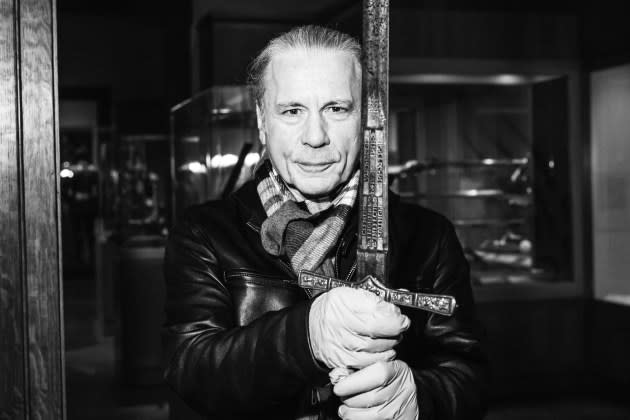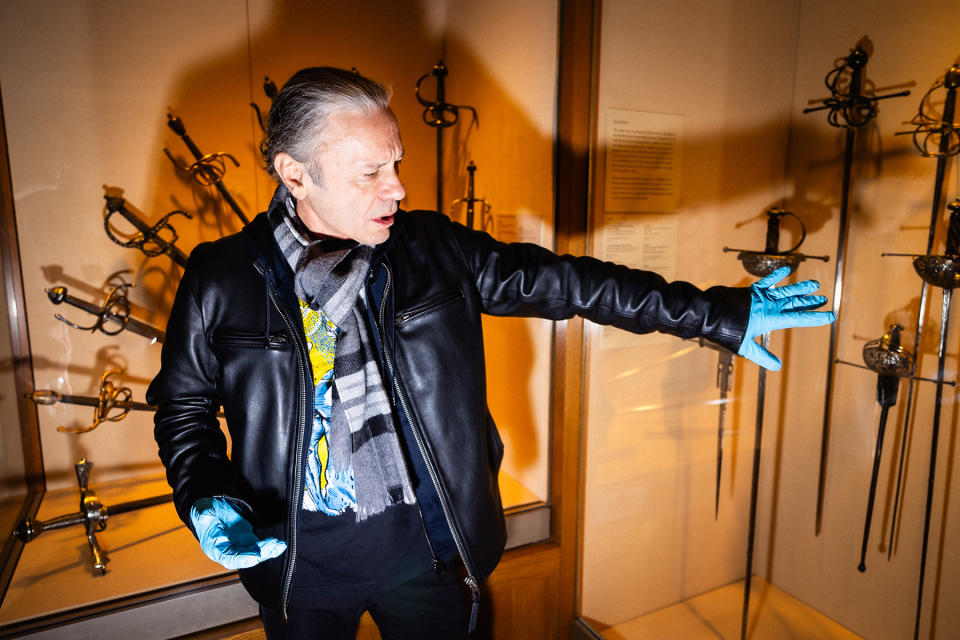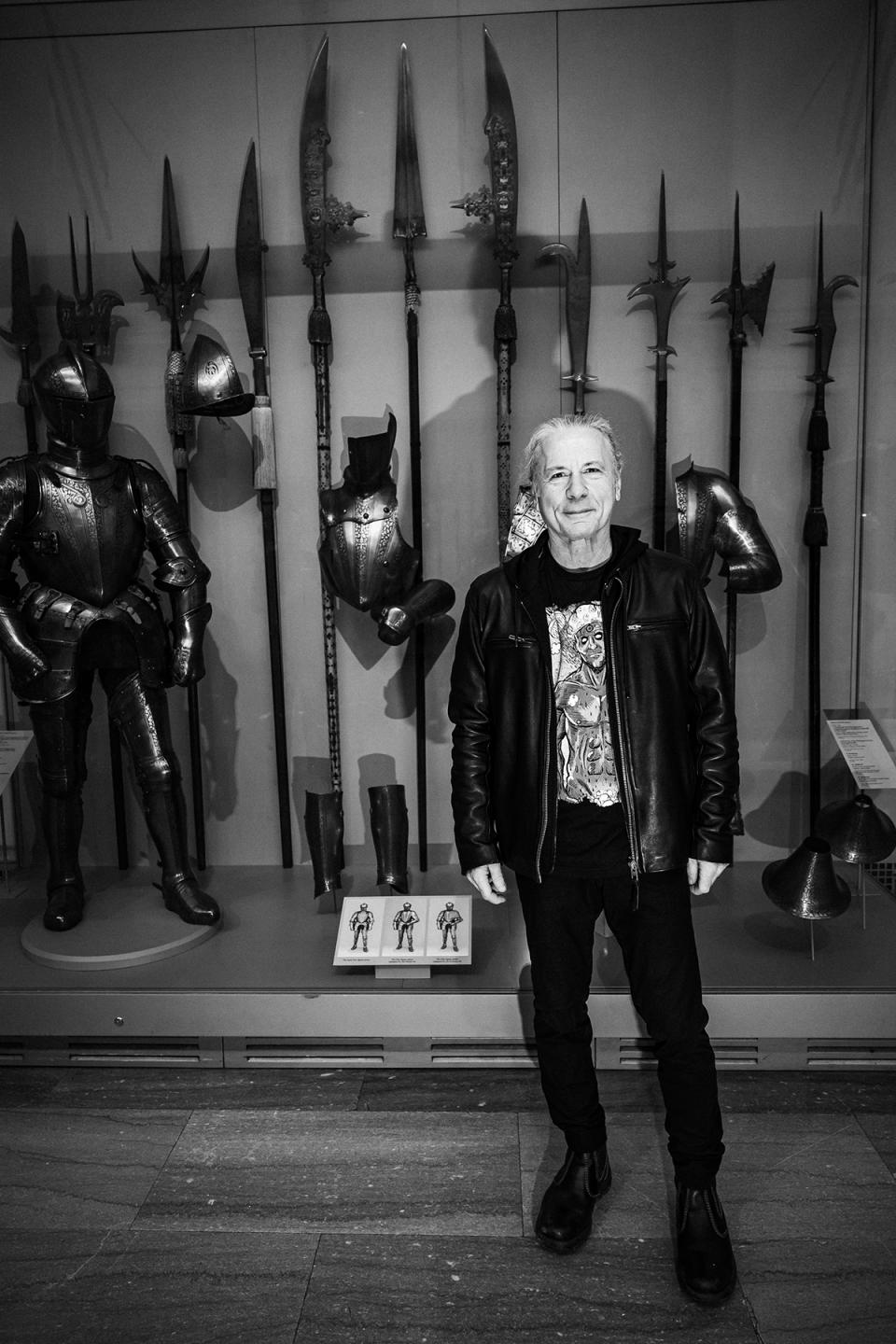Bruce Dickinson, Singer and Sword Master, on Why ‘Life Is Better Than All Other Options’
- Oops!Something went wrong.Please try again later.

Bruce Dickinson is brandishing a sword in an attack stance with a smile on his face. “This is super, super light,” he says. “It’s really usable.”
Luckily for everyone within striking distance, the Iron Maiden frontman knows the weapon is too precious for mere murder, since the blade is a 400-year-old cross hilt sword. Moreover, Dickinson is holding it safely inside New York’s highly public Metropolitan Museum of Art with the curator of the museum’s Arms and Armor collection observing nearby. “This sword is a fine example of the most fashionable type that was worn by noblemen in England at the time of King James I,” reads the placard inside the case from which it was plucked. Dickinson finds both the weapon’s history and its potential for bloodshed appealing, as he lifts it — with Rolling Stone’s photographer’s permission — as if he’s going to strike down a pesty member of the paparazzi.
More from Rolling Stone
'A Guy Walks Into a Churchyard and Meets the Devil': Bruce Dickinson Explains 'Rain on the Graves'
Enough Is Enough. It's Time for the Rock Hall to Recognize Metal
As it happens, the typically upbeat singer is in high spirits. He even poses for a photo with a security guard who recognizes him in his street gear: a leather jacket, a gray beanie, and a tote bag. Even when ostensibly incognito, Iron Maiden’s self-proclaimed “human air-raid siren,” whose voice has wailed “Run to the Hills,” “The Trooper,” and “2 Minutes to Midnight” more than a thousand times each at concerts all over the world, stands out. People also notice him because of the way he recites historical facts about ancient weaponry, sounding like he could be a museum tour guide, even though this January afternoon is his first time ever visiting the institution.
“I’ve got one of those at home,” he says, pointing to a fencing épée, as the collection’s curator safely stows the cross-hilt. “And I have a left-hand dagger like that one. Mine’s not quite as nice.”
Dickinson fell in love with swords and fencing around age 14, while attending an English boarding school and studying metalworking. A teacher showed him how to forge a blade and, since the same man also taught fencing, he showed the budding singer how to use it. Dickinson now owns “a very small collection” of antique swords, foils, and other sharp, jabby things. Some of his favorites include a Spanish cup-hilt rapier, a defensive left-hand dagger from the 15th century, and a Napoleonic cavalry saber. Fencing has long been one of Dickinson’s many interests — in addition to flying planes, writing books, and crafting beer — which he’s explored over the past half-century when he hasn’t been leaping around onstage.
He’s in New York on a short visit to promote his new comic-book series, The Mandrake Project, which ties into his upcoming solo album of the same name. The singer, who has salt-and-pepper hair now, turned 65 this past August, and he has no interest in retirement, so he’s eager to keep working.
Since he is no stranger to big, sweeping overtures when it comes to his music — this is the guy who still waves a Union Jack during “The Trooper” and duels with Iron Maiden’s zombie mascot, Eddie, during “Iron Maiden” — he’s barely breaking a sweat as he ramps up to a 360-degree album rollout, which includes dozens of tour dates with his solo band in Europe and the Americas. He’s arranged these, of course, in addition to a tour with Iron Maiden lasting the rest of the year, including U.S. dates in the fall.

Managing such an intense schedule and many interests has never been a problem for him. “My teachers at school said, ‘You have a grasshopper brain,'” Dickinson says. “They thought that was a bad thing. I thought that was a superpower to be able to just bounce from one idea to another idea to another idea.”
At this point in our visit to the Met, Dickinson has gotten his fill, at least temporarily, of examining the museum’s centuries-old cutlery, so we’ve now bounced over to a café for a pick-me-up. His wife, who looked amused as he balanced the Jacobean sword on his hand, leaves us to check out the European paintings.
We settle down at a table. Gold and marble statues hold their poses patiently in the hall around him, but Dickinson remains animated. “I’ve learned to tone the grasshopper brain down a little bit, so you can jump onto the lily pad and stay there with sufficient dwell-time to actually achieve something,” he says. “I’m just endlessly curious.”
The Mandrake Project, both as an album and a comic book, is rich with allusions that reflect Dickinson’s curiosity. Norse mythology comes up on “Afterglow of Ragnarok”; there’s a nod to poet Percy Bysshe Shelley’s “Prometheus Unbound” in “Many Doors to Hell”; and poet-illustrator William Blake’s ghost is a character in the comic book. (Dickinson also recreated Blake’s illustrations and headstone in the video for “Rain on the Graves.”)
Both Beethoven and Sleeping Beauty figure in the stunning “Sonata (Immortal Beloved),” a sprawling, 10-minute stream-of-consciousness meditation on death. “Save me now,” he sings mournfully, almost like a heavy-metal Nick Cave, on the song. “Save me from this pain … bring me back.”
“Sonata” is the most moving and original song Dickinson has ever recorded outside of Iron Maiden. (“Yeah, yeah, yeah, I knew you were going to say that,” he replies with deadpan wit when told as much.)
Dickinson has been sitting on the song for about 25 years now, and he almost left it off this album. He’d forgotten he’d even recorded it until going through his archives for the album. His wife, Leana, “who’s got pretty good taste in music, luckily for me,” told him it was “the most emotional thing I’ve ever heard you sing.” When he told her he’d never considered releasing it, she politely asked if he was insane.
The song came about as a jam with his longtime collaborator Roy Z, who has worked with Dickinson on nearly all of his solo releases going back to 1994’s Balls to Picasso, home to the similarly stunning power ballad “Tears of the Dragon.” The guitarist and producer had seen the Beethoven biopic Immortal Beloved, and stayed up all night exploring the chord changes to the Moonlight Sonata. Neither he nor Dickinson knew what to do with it, but the singer decided to take a shot at improvising a vocal line and lyrics.
He closed his eyes, imagined himself in a dark forest, and the verses just poured out of him. “I was thinking I might make some melodic, singing-type noises and then I’d write some words and then redo it again,” he says. “But that’s not what happened.” Visions of Sleeping Beauty entered his mind followed by the Angel of Death. “It could very easily have been something out of Monty Python and the Holy Grail, but I got ’round that,” he says. Instead he surprised even himself with his own words: “For love has brought you here, and love will tear you apart.” (Incidentally, Dickinson says he’s not a Joy Division fan.)
“That’s life,” he says of those words. “That’s tragedy. That’s all of it: love that should have been but was never meant to be.”
Dickinson understands tragedy, since he narrowly averted it about a decade ago. In 2015, he revealed he’d been diagnosed with throat cancer, which he describes as a “three-and-a-half–centimeter, golf ball–sized tumor in the base of my tongue and a strawberry–sized one in my lymph node.” He went through 33 radiation sessions and nine weeks of chemotherapy at the same time. “I love the medical term,” he says. “They describe that [therapy] as a ‘significant insult to the body.'”

The insult was worth it. Dickinson is now cancer-free. Sipping coffee and looking around the gallery, he’s grateful to be alive. “I really appreciate every day, but that means that every day I have to do something, even if it’s consciously doing nothing — at least do something consciously,” he says. “When I did my series of one-man shows around the States almost two years ago, I made up as a T-shirt that said, ‘Life is better than all the other options.’ And if I had a mantra to live by, that would be it.
“I’m lucky that I can still sing,” he continues. “So if I can somehow do anything that entertains people, makes people think more, feel more, do more things, then I’m doing something good. I’m big into trying to make people feel things now rather than being impressed with myself and going, ‘Oh, look at me.’ It’s actually, ‘No, no. Look at you.’ If you can manage to listen to an album during 58 minutes of your life that you’ll never get back again, it’s a musical and emotional journey. That was really important to me because it’s something that I never achieved explicitly ever with any band, including Iron Maiden. In Iron Maiden, the music does move people, but in a slightly different way. The emotions are slightly different. With this one, I’ve got a bigger palette to paint from.”
Now he wants to experience everything life offers and create even more. Ever since he read the literary graphic novel Watchmen, he’s appreciated comics as a way of telling a nuanced story. So why not make one of his own? (Underneath his leather jacket, he’s wearing an ironic Washman T-shirt, which shows Doctor Manhattan in the tub, scrubbing up.) He doesn’t know if Iron Maiden will ever make another record (though he’s not saying they won’t), so why not record a solo album and tour it around the world and write a 12-part comic book series that connects the songs — and also tour with Iron Maiden? If he can, he says, he will.
After about an hour of discussing all life’s possibilities, Dickinson takes a phone call and remembers he has to meet a friend who wants to show him some interesting fencing equipment before he catches a plane out of New York. He picks up his tote bag, says hello to his wife as she returns from the European paintings, and we walk out through the museum’s Egyptian wing. “It’s on my bucket list to go to Egypt,” Dickinson says, as we pass the Temple of Dendur. “I’ve never been.” This is a curious fact, since Iron Maiden’s 1984 album, Powerslave, famously featured Egyptian–inspired cover art and their stage set for the tour had a sphinx-like Eddie. “I was going to say, we should have gone then,” he says.
But Dickinson has a new resolve to appreciate life now. As he heads toward the exit, what echoes through the grand hall is something he said earlier, quoting William Blake’s poem “Jerusalem.” “My business is to create,” Dickinson observed. “That’s what I do.”
Best of Rolling Stone

